

Extend WiFi With Wireless Access Point - Blog of FS.COM. Our life and work have been greatly changed by the wireless technology like WiFi.
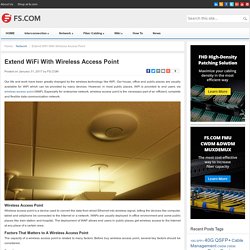
Our house, office and public places are usually available for WiFi which can be provided by many devices. However, in most public places, WiFi is provided to end users via wireless access point (WAP). Especially for enterprise network, wireless access point is the necessary part of an efficient, complete and flexible data communication network.
Wireless Access Point Wireless access point is a device used to convert the data from wired Ethernet into wireless signal, letting the devices like computer, tablet and cellphone be connected to the Internet or a network. Factors That Matters to A Wireless Access Point The capacity of a wireless access point is related to many factors. Speed The price of a wireless access point is closely related to the speed that it can support. Power Supply The wireless access point is an active device which means it requires electrical power during working. Terminals and Coverage. Use 28AWG Copper Patch Cords in Data Center - Blog of FS.COM. Most people use copper patch cords with 24AWG copper conductors today.
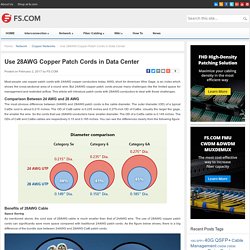
AWG, short for American Wire Gage, is an index which shows the cross-sectional area of a round wire. But 24AWG copper patch cords arouse many challenges like the limited space for management and restricted airflow. This article will introduce patch cords with 28AWG conductors to deal with those challenges. Comparison Between 24 AWG and 28 AWG. Should We Choose Punch Down or Feed-through Patch Panel? - Blog of FS.COM. Copper patch panels provide a useful solution for cable management in data centers and other high-density environments.
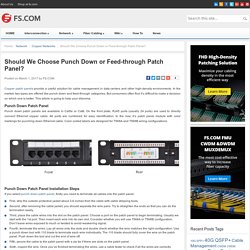
In the market, two types are offered like punch down and feed-through categories. But consumers often find it’s difficult to make a decision on which one is better. This article is going to help your dilemma. Punch Down Patch Panel Punch down patch panels are available in Cat5e or Cat6. Punch Down Patch Panel Installation Steps If you select punch down patch panel, firstly you need to terminate all cables into the patch panel. First, strip the outside protective jacket about 3-6 inches from the cable with cable stripping tools.Second, after removing the cable jacket, you should separate the wire pairs.
When the punching down process is completed, you can install the patch panel into the racks with screws. Get Well Known About RJ45 and RJ11. Posted on February 3, 2017 by FS.COM Tags: rj45 , rj45 connectors RJ, short for registered jack, is a standardized networking interface.
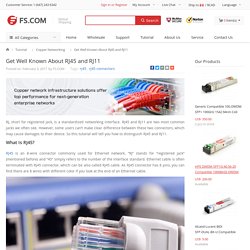
RJ45 and RJ11 are two most common jacks we often see. However, some users can’t make clear difference between these two connectors, which may cause damages to their device. Test Copper Cables With Wire Mapping Tester. Many copper cables installed today are twisted-pair cables.

The number of individual wire connections involved makes the installation and testing process more complicated than for other cable, especially in light of the various standards available for the connector pinouts. This tutorial will focus on the wire mapping tests for copper cables. What Is Wire Mapping Test? Wire mapping is the most basic and obvious test for any twisted-pair cable installation. For twisted-pair cables, you must test each cable run to make sure that the individual wires within the cable are connected properly. A wire mapping test can be performed visually by simply checking the pinouts at both ends of the cable, but problems can occur that are not visible to the naked eye. What Can Wire Mapping Tester Do? A wire mapping tester transmits signals through each wire in a copper twisted-pair cable to determine if it is connected to the correct pin at each end. How to Test Faults? Summary. Differences Between Phone & Network Cable - Fiber Transceiver Solution. When connecting the computer to the network devices like switches and routers, you must use a network cable, namely an Ethernet patch cable.
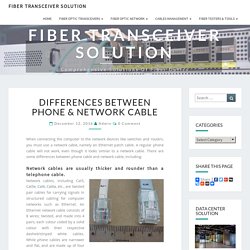
A regular phone cable will not work, even though it looks similar to a network cable. There are some differences between phone cable and network cable, including: Network cables are usually thicker and rounder than a telephone cable. Network cables, including Cat5, Cat5e, Cat6, Cat6a, etc., are twisted pair cables for carrying signals in structured cabling for computer networks such as Ethernet.
An Ethernet network cable consists of 8 wires; twisted, and made into 4 pairs, each colour coded by a solid colour with their respective dashed/striped white cables. Pre-terminated Copper Trunk Cables Selection Guide. Pre-terminated copper trunk cable assemblies are designed to provide a fast and simple way for data centers backbone and cross-connect cabling installation.
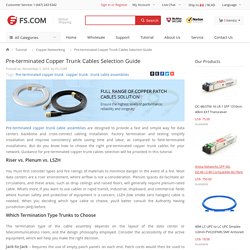
Factory termination and testing simplify installation and improve consistency while saving time and labor, as compared to field-terminated installations. But do you know how to choose the right pre-terminated copper trunk cables for your network. Guidance for pre-terminated copper trunk cables selection will be provided in this tutorial. Riser vs. Plenum vs. You must first consider types and fire ratings of materials to minimize danger in the event of a fire. Which Termination Type Trunks to Choose The termination type of the cable assembly depends on the layout of the data center or telecommunications room, and the design philosophy employed.
Jack-to-Jack – Requires the use of empty patch panels on each end. Selecting the Appropriate Trunks Length Trunk Cable Length = (A1+A2+A3) + X + (B1+B2+B3) where: Conclusion.